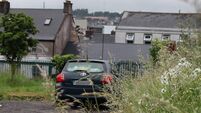Trevor Laffan: Pause and engage... how we can break the cycles of crime

The finding is so prevalent, it is being referred to as the ‘law of crime concentration’.
In addition, internationally, the distribution of crime is not random. A small proportion of targets and places experience a vastly disproportionate amount of crime, so the same offenders and the same victims are involved in most of the crime that occurs.
Many studies have found about 2% of potential targets and locations suffer more than half of crime.
In Ireland, the CSO (Central Statistics Office) re-offending data states 84% of young adults, under 21, re-offended within three years of being released from prison.
In another study, the Alliant International University in California found substantial data correlates low socioeconomic standing, low income, poor financial literacy, or poverty, with a high likelihood of incarceration.
Those who faced these socioeconomic implications were 20 times more likely to be pushed to commit crime than those of the same age from high-earning families.
Decades of data supports the correlation between a young adult’s family instability and juvenile delinquency. In other words, those who experience a turbulent and unstable home life are statistically more likely to commit crimes during their youth.
reported that the Mayor of London, Sadiq Khan’s City Hall analysis in December, 2021, revealed some complex factors in people’s lives, homes and communities that could alter the likelihood of someone taking the wrong path and turning to violence.
These included issues like poverty, inequality, high unemployment, school exclusions, poor mental health, and a lack of youth services.
So, it’s fair to say, a huge body of research has come to the same conclusion as far as the participants of criminal activity are concerned but it is hardly earth-shattering news.
The data has a familiar theme running through it, and anyone with policing experience will recognise it immediately.
From my 35 years in policing, I’m certain that what has been identified by this research can be applied to every town and city in every jurisdiction. What isn’t so obvious though is what the remedies are. How do you break the cycle?
First and foremost, there is no magic wand solution. The research agrees that the environment children grow up in can impact how they turn out in life, and there will always be disadvantaged, socially deprived areas.
But while we may not be able to change that, we can certainly influence how young people who live in these areas behave and how they develop.
In dealing with the actual problem locations and estates, Cork City Council, An Garda Síochána and the local communities got together and, using the theory of the ‘broken window’, identified issues as they arose and dealt with them before they festered.
Engagement with younger members of the community also proved vital. After all, young people shouldn’t be written off just because of their address. A positive interaction with children pays dividends in later years when those children become young adults.
That was my experience, and it started by talking with them in the schools.
Communities working closely with gardaí and the local authority made great strides in improving the physical environment too, and everyone benefitted.
Unfortunately, the economy took a downturn, and priorities were focused elsewhere which, in hindsight, was a serious mistake.
We need to fix that and return to the basics. All this research would seem to support that, but putting the genie back in the bottle is tricky.
An Garda Síochána would also need to properly resource community policing to support the local authority, but with their current difficulties with recruitment and retention, that seems unlikely too.
But maybe there is a glimmer of light at the end of the tunnel.
Sean O’Riordan reported in the last October that a new forum was to be set up in County Cork to focus on addressing rural crimewaves, including anti-social behaviour and speeding.
It is to include community representatives, gardaí, council officials, and councillors.
One councillor recalled that they used to have such a meeting prior to the covid pandemic, and he suggested it was essential to restart those, while another councillor said: “We need a joined-up approach.”
So that all sounded very positive, but maybe it was just too good to be true because soon after this move was announced, Sean again reported that it had been branded “an absolute disgrace” by councillors because, under Department of Justice rules, only seven of the county’s eight municipal districts will be represented on it.
The new fora, or partnerships, are set to replace the former joint policing committees which were disbanded a few years ago, but already there is a row brewing over the number of fora the county is entitled to have.
Labour councillor Cathal Rasmussen, who was the last chairman of the county’s joint policing forum, said, “It’s an absolute disgrace.”
So, before it even gets off the ground, councillors are already suggesting the forum will not work. So much for the ‘joined-up’ approach.
I suggest councillors should get this thing up and running as soon as possible. There’s too much at stake and enough time has been wasted already.
They can argue about the design of it later.







 App?
App?







